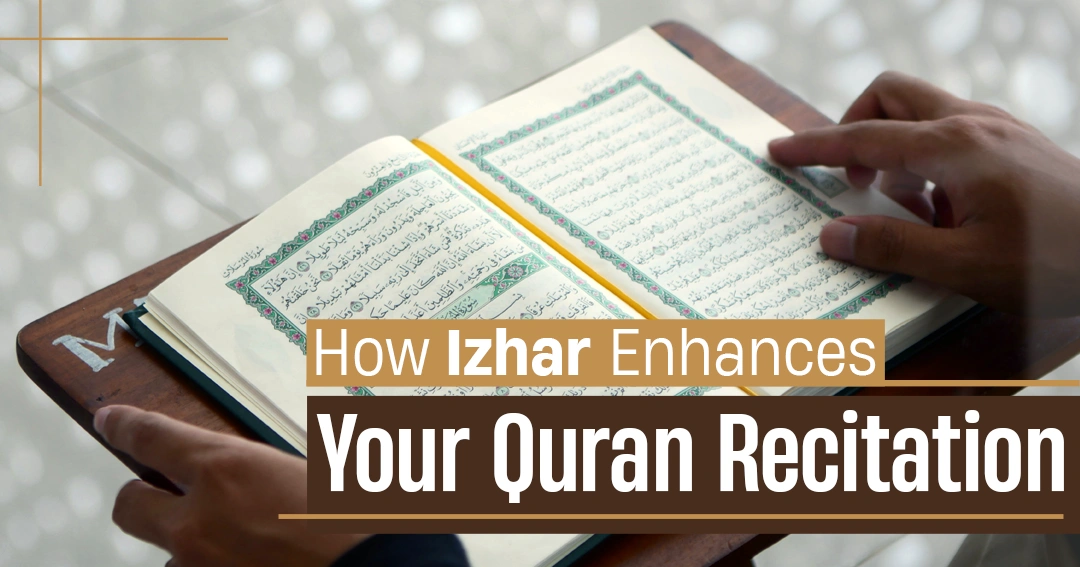Izhar in Quran recitation is a significant Tajweed rule that brings clarity and correctness in pronunciation. It refers to the clear and distinct pronunciation of the letter Hamza (ء) when it appears before any of the throat letters (such as Ha, Kha, or Ayn).
Mastering Izhar in Quran recitation not only enhances your recitation but also helps in preserving the beauty and rhythm of the Quran. In this article, we’ll explore examples and insights into how this rule can elevate your Quranic recitation skills.
What is Izhar in Quran Recitation?
Izhar translates to “manifestation” or “clarity” in Arabic, and it is all about maintaining some of the sounds clean and clear as you recite the Quran. With proper application, Izhar smooths your recitation and makes it sound so precise, exactly the way it was intended to be.
If you are beginning your Tajweed journey, understanding Izhar in Quran recitation is among the first crucial steps.
Izhar in Quran recitation takes place when one of the six special letters, i.e., (ء، هـ، ع، ح، غ، خ), comes after a Noon Saakinah (نْ) or Tanween (ً ٍ ٌ). Instead of creating a blend of sounds, you pronounce the Noon or Tanween without any nasalizing or blending.
This exemption helps to preserve the clean and proper meaning of the Quranic letters so that each letter gets its rightful share in your recitation.
What are the Types of izhar?

As you move further along in Tajweed, you should be aware that Izhar in Quran recitation is not a single rule by itself, it comes in different types based on where and how it is applied.
Being aware of these types makes your recitation more precise and understandable, thus easier for you to adhere to the correct pronunciation.
There are mainly two types of Izhar in Quran recitation:
Izhar Halqi (Throat Izhar)
Izhar Halqi is the most common and the first type of Izhar in Quran recitation that each student encounters. “Halqi” means “throat,” Noon Saakinah or Tanween sound is made clear if it comes before one of six throat letters: (ء، هـ، ع، ح، غ، خ).
Since these sounds are made in the throat, you make the Noon or Tanween with a clear pronunciation without making any nasal sound. It is very important to practice Izhar Halqi to obtain a smooth and correct reading of the Quran.
Izhar in Quran recitation: Izhar Shafawi
Izhar Shafawi is applied to the letter Meem (مْ). It occurs when a Meem Saakinah is preceded by any letter other than Meem (م) and Baa (ب). In this situation, the Meem is pronounced clearly without joining or hiding the sound.
Although most students focus on Izhar with Noon and Tanween, learning Izhar Shafawi is as important for improving your overall recitation skills of the Quran.
As you get to know the types of Izhar in Quran recitation, it is extremely useful to learn from expert tutors who give you explanations of these types.
Professional tutors at Tareequl Jannah Academy take you through each step with actual examples and tailored practice so that you become confident in both Izhar Halqi and Izhar Shafawi.
When and How Izhar is Applied?
Understanding when and how Izhar in Quran recitation is applied is a wonderful accomplishment for every Quran learner. Once you become aware of the conditions and get them right, your recitation will sound clearer and consistent with Tajweed rules.
Izhar in Quran recitation occurs when Noon Saakinah (نْ) or a Tanween (ً ٌ) is immediately preceded by one of six defined throat letters:
(ء, هـ, ع, ح, غ, خ).
When so, the Noon or Tanween must be pronounced and distinct, without any nasalizing (Ghunna) or merging (Idgham). The sound must come directly from the mouth or throat area, depending on the following letter.
How to correctly apply Izhar in recitation of the Quran:
- Relax momentarily at the Noon or Tanween sound.
- Say it clearly, although it might slightly be separated from the following letter.
- Don’t merge the Noon or Tanween with the following throat letter.
- Listen attentively to good reciters to hear how the sound is not merged.
For example:
In the verse “مِنْ عِلْمٍ” (min ‘ilmin), you will need to pronounce the Noon sound before moving to the letter ‘Ain (ع).
An example is “عَذَابٌ أَلِيمٌ” (‘adhaabun aleem), where Izhar with Tanween is pronounced clearly before Hamzah (ء).
If you do find these rules a bit scary at first, don’t worry! At Tareequl Jannah Academy, professional tutors guide you carefully through real-life examples from the Quran and give you one-to-one feedback.
Importance of Learning Izhar
Izhar is a fundamental Tajweed rule. After learning it, it’s easier to know it from other rules such as Ikhfa and Idgham. That’s why learning and regular practice with the help of good examples of izhar from the Quran is a must.
Learning Izhar also prevents mistakes that could change the meaning of words, something all learners should be aware of. Whether you’re a young student or a parent learning Quran, understanding Tajweed rules like Izhar is a great step forward.
The Prophet Muhammad ﷺ emphasized the value of reciting the Quran with care and excellence. The prophet said:
“The best of you are those who learn the Quran and teach it.” (Sahih al-Bukhari, 5027)
Learning izhar in quran recitation and its rules allows us to preserve the words of Allah by fulfilling our responsibility as Muslims and Quran learners.
Practicing examples of izhar in tajweed, students train themselves to pronounce words correctly, thus avoiding most errors that could shift the meaning of a verse.
Top 5 Examples of Izhar

Below are some examples of Izhar Halqi from the Quran and the correct Makharij of Izhar letters:
1. Izhar with Hamza (ء):
An example of Izhar in Quran recitation can be found in the verse:
{وَهُمْ يَنْهَوْنَ عَنْهُ وَيَنْأَوْنَ عَنْهُ}
(wa-hum yan-hawoon ʿanhu)
“And they prevent others from him and they keep away from him.” (Surah Al-An’am, 6:26)
In the phrase {وَهُمْ يَنْهَوْنَ عَنْهُ} (wa-hum yanhawoon ʿanhu), the Hamza (ء) in يَنْهَوْنَ (yanhawona) is followed by the letter “ه” (h) in عَنْهُ (ʿanhu). According to the Izhar Halqi rule, the Hamza (ء) is pronounced clearly and distinctly.
2. Izhar in Quran recitation with Ha (ه):
Another example of Izhar Halqi appears in the verse:
{وَيَنْأَوْنَ عَنْهُ}
(wa-yan-ʾawnoona ʿanhu)
In the phrase {وَيَنْأَوْنَ عَنْهُ} (wa-yan’awnoona ʿanhu), the Hamza (ء) in وَيَنْأَوْنَ (wa-yan’awnoona) is followed by the letter “ه” (h) in عَنْهُ (ʿanhu). Therefore, the Izhar Halqi rule applies here as well, requiring the Hamza (ء) to be pronounced clearly and distinctly.
3. Izhar with Ha (ح):
In this verse, we see Izhar in Quran recitation with the letter “ح”:
{يُوَادُّونَ مَنْ حَادَّ اللَّهَ وَرَسُولَهُ}
(yuwaddun man ḥadda llāha wa-rasūlahū)
“They befriend those who oppose Allah and His Messenger.” (Surah Al-Mujadila, 58:22)
The Hamza (ء) in the word يُوَادُّونَ (yuwaddun) is followed by the letter “ح” (Haa), and thus, the Izhar Halqi rule requires a clear and distinct pronunciation of the Hamza (ء).
4. Izhar with Kha (خ):
In this verse, the Izhar in Quran recitation rule applies with the letter “خ”:
{وَمَا أُهِلَّ لِغَيْرِ اللَّهِ بِهِ وَالْمُنْخَنِقَةُ وَالْمَوْقُوذَةُ وَالْمُتَرَدِّيَةُ}
(wa mā uhillal li-ghayri llāhi bihi wal-munkhaniqatu wal-mawqudhatu wal-mutaraddiyatu)
“And that which is sacrificed to other than Allah, and that which is strangled, and that which is beaten (to death), and that which dies of a fall.” (Surah Al-Ma’idah, 5:3)
Here, the Hamza (ء) in أُهِلَّ (uhillal) is followed by the letter “خ” (Khaa), applying the Izhar Halqi rule where the Hamza (ء) is pronounced clearly.
5. Izhar in Quran recitation with Ayn (ع):
An example of Izhar Halqi with the letter “ع” appears in the verse:
{مَنْ عَمِلَ صَالِحًا مِّن ذَكَرٍ أَوْ أُنثَى}
(man ʿamila ṣāliḥan min dhakaran aw unthā)
“Whoever does righteous deeds, whether male or female.” (Surah An-Nahl, 16:97)
In this case, the Hamza (ء) in عَمِلَ (ʿamila) is followed by the letter “ع” (Ayn), and the Izhar Halqi rule applies, with the Hamza (ء) being pronounced clearly and distinctly.
Easy Practice Tips to Master Izhar

Learning Izhar in Quran recitation is a simple task that can be mastered through constant practice. These are some helpful tips for you to learn it easily:
1. Listening to Expert Reciters
One of the best ways of practicing Izhar in Quran recitation is to listen to experienced Quran reciters attentively. Listen very carefully to how they pronounce Noon Saakinah or Tanween separately, not merging the sound with the following letter.
Imitate them and practice. This internalizes the correct pronunciation as well as the rhythm.
2. Practice with Short Surahs
Start with short surahs that typically comprise Izhar in Quran recitation examples. Surahs like Al-Fil, Al-Ma’un, and Al-Qari’ah are good ones for beginners.
Make slow recitation a practice by taking a break and focusing on properly reciting Izhar. With this rehearsal of these surahs, you’ll get used to the sound and ensure proper recitation.
3. Record and Listen to Yourself
One of the best methods to track your progress is to record your recitation. Listening to yourself will help you decide if you’re pronouncing the Noon or Tanween correctly. This self-criticism allows you to identify any mistakes early and rectify them, speeding up your learning process.
4. Get Personalized Guidance
While these tips are helpful, the most effective way to become an expert in Izhar in Quran recitation is through instruction from a professional instructor.
Tareequl Jannah Academy offers individualized Tajweed classes where experienced instructors provide step-by-step guidance and live feedback. Their personalized lessons will help you remove any mistakes and become a master of Izhar with accuracy and assurance.
Conclusion
In short, it is important to master Izhar in Quran recitation to achieve accurate and beautiful recitation. By understanding and practicing the rules of Izhar, students can enhance their pronunciation and preserve the actual spirit of the Quranic words.
With consistent practice, you can apply Izhar confidently in your recitation, which will guide you to the perfection of Tajweed.




